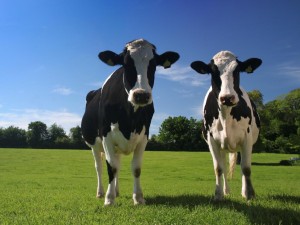There are many players in the industrial farming industry. But maybe there are not as many as there used to be. As little as 40 years ago the top five beef packers controlled about 25% of the market. Today, the top four control over 80% of the same market. As shown in Food, Inc. there were thousands of functioning slaughterhouses. Today there are only 13 in the United States. Perhaps one of the largest players in the food industry would be Monsanto, who back in the 1950s was a chemical company that produced things like DDT and agent orange. Robert Kenner, director of Food, Inc., believes that large corporations such as Monsanto have created a monopoly on the majority of the food industry in the United States. Because of this, regulations and food safety have become secondary to the bottom line of these corporations and people, like Tom Roush who was sued by Monsanto because of patent infringement, are suffering because of it.
These large scale agriculture corporations are able to control regulations through lobbying the government. As Mariam Nestle said in her book “Resisting Food Safety,” there has been a “historic closeness of working relationships among congressional agriculture committees, federal regulatory agencies, and food producers.” As we saw in the Bush administration the head of the FDA, Lester M. Crawford Jr., was also the former executive VP of the National Food Processors Association and the chief of staff at the USDA, James F. Fitzgerald, was the former chief lobbyist for the beef industry in Washington. With all the food borne illness in the United States you would think that Congress or the federal government would intervene at some point. However there are people like David Bossman, recent CEO of the American Feed Industry Association, who argued to congress that “… you can eat meat with confidence not only because it is safe, but it is getting safer with all the things that industry is doing.” Notice that he did not say what the government was doing to make meat safer but what the industry was doing. Consumer Reports would argue in “You Are What They Eat,” that the lack of regulation within this industry is what has created this major problem within our feed stock. They argue that the antibiotics we feed animals and the actual feed both pose major health risks to the American people especially if there is no one to regulate it.
In 1972, the FDA conducted 50,000 food safety inspections. In 2006, the FDA conducted only 9,164. One might be able to argue that this decrease in the number of federal safety inspections would lead to a higher incidence of outbreak of major food borne illnesses like salmonella and E. coli 0157h7. The USDA once was able to test for those types of bacteria in processing plants and if a facility repeatedly failed tests the government had the authority to shut it down. That is until meat and poultry associations sued the government and the USDA lost that power. In the article by Consumer reports, people like Carol Tucker-Foreman, argue “Rules protecting the feed supply aren’t as strong as they should be, and the FDA enforcement has been more wishful thinking then reality. Contaminated animal feed can result in contaminated food, putting the public health at risk. It is also argued that these major food industries have condensed living conditions for animals and have huge processing plants for meat which increase their risk for viruses, diseases and cross contamination. The largest in the world, in Tar Heel, N.C, is Smithfield Hog Processing Plant where approximately 32,000 hogs are killed every day. This increased risk of infection and disease leads conventional farms to imbed antibiotics within the chicken or cow feed to reduce this risk. The conditions that are described are the same as the conditions represented in Food Inc,. Carol Doberstein lost her contract with a major chicken distributor because she refused to create a completely blacked out environment for her chickens. Another farmer described in Food Inc. was Paul Salitin who displayed his methods of farming to far less likely to have any incidents of food borne illness despite his open air work environment. Maybe his methodology of wholesome organic foods and food processing is the way to go.
People like Blake Hurst would disagree with this idea of what organic farming is. In his article “Organic Illusions” he cites a study by Stanford that concludes the idea of organic farming is not actually safer nor is there any extra nutritional value to be gained from it. He says that there was actually a higher percentage of E. coli in organic foods than in conventionally farmed foods. He does not think the idea of organic farming is based in science saying “we are not having a debate over science, because that science is settled. We’re having a debate about processes, narratives, and good intentions, and maybe even about style.” He believes in telling a story. And in his article he is trying to portray organics as a phase and something that is unrealistic to the average farmer. It is interesting that at the beginning of his article he acknowledges that Stanford, the only source he uses, has actually received large donations from Cargill, who is a major food company that ranked 12 on the Fortune 500.
